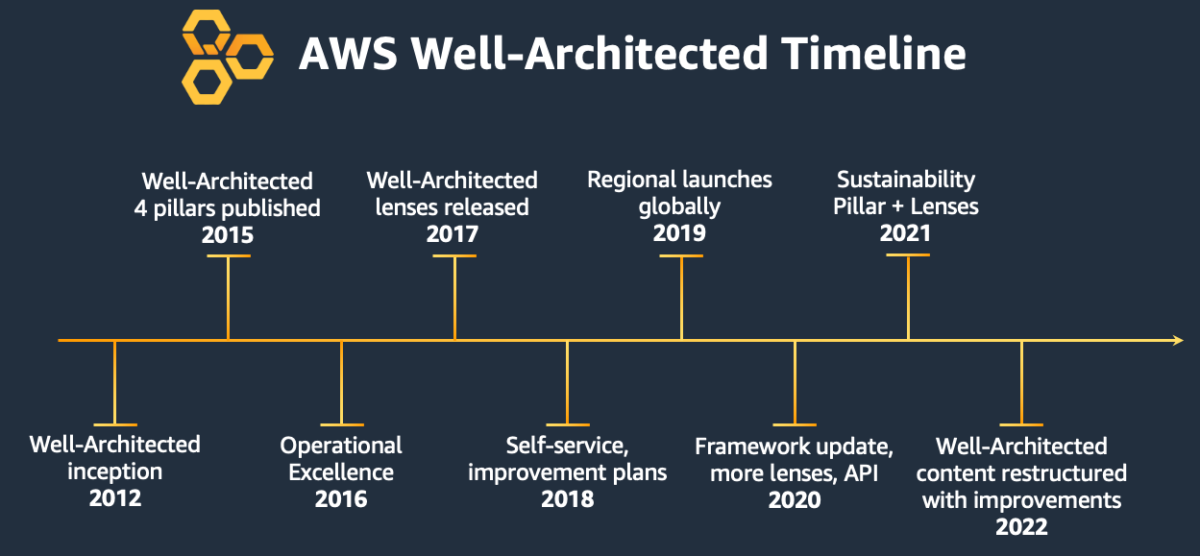
Announcing updates to the AWS Well-Architected Framework

A brief history The AWS Well-Architected Framework is a collection of best practices that allow customers to evaluate and improve the design, implementation, and operations of their workloads in the cloud… In 2022, dedicated pages were introduced for each consolidated best practice across all s…
We are excited to announce the availability of improved AWS Well-Architected Framework guidance. In this update, we have made changes across all six pillars of the framework: Operational Excellence, Security, Reliability, Performance Efficiency, Cost Optimization, and Sustainability.
A brief history
The AWS Well-Architected Framework is a collection of best practices that allow customers to evaluate and improve the design, implementation, and operations of their workloads in the cloud.
In 2012, the first version of the framework was published, leading to the 2015 release of the guidance whitepaper. We added the operational excellence pillar in 2016. The pillar-specific whitepapers and AWS Well-Architected Lenses were released in 2017, and, the following year, the AWS Well-Architected Tool was launched.
In 2020, the content for the Well-Architected Framework received a major update, as well as more lenses, and API integration with the AWS Well-Architected Tool. The sixth pillar, Sustainability, was added in 2021. In 2022, dedicated pages were introduced for each consolidated best practice across all six pillars, with several best practices updated with improved prescriptive guidance.
What’s new
Well-Architected Framework content is consistently updated and improved in order to adapt to the constantly changing and innovating AWS environment, with new and evolved emerging services and technologies. This ensures cloud architects can build and operate secure, high-performing, resilient, efficient, and sustainable systems in the AWS Cloud.
The content updates and improvements in this release focus on providing more complete coverage across the AWS service portfolio to help customers make more informed decisions when developing implementation plans. Services that were added or expanded in coverage include: AWS Elastic Disaster Recovery, AWS Trusted Advisor, AWS Resilience Hub, AWS Config, AWS Security Hub, Amazon GuardDuty, AWS Organizations, AWS Control Tower, AWS Compute Optimizer, AWS Budgets, Amazon CodeWhisperer, and Amazon CodeGuru.
Pillar updates
The Operational Excellence Pillar has a new best practice on enabling support plans for production workloads. This Pillar also has a major update on defining a customer communication plan for outages.
In the Security Pillar, we added a new best practice area, Application Security (AppSec). AppSec is complete with eight new best practices to guide customers as they develop, test, and release software, providing guidance on how to consider the tools, testing, and organizational approach used to develop software.
The Reliability Pillar has a new best practice on architecting workloads to meet availability targets and uptime service-level agreements (SLAs). We also added the resilience shared responsibility model to its introduction section.
The Cost Optimization Pillar has new best practices on automating operations as a part of cost-optimization efforts and enforcing data-retention policies.
In the Sustainability Pillar, we introduced a clear process for selecting Regions, as well as tools for right-sizing services and improving the overall utilization of resources in the AWS Cloud.
Best practice updates
The implementation guidance and best practices have been updated in this release to be more prescriptive, including enhanced recommendations and steps on reusable architecture patterns targeting specific business outcomes in the AWS Cloud.
As many as 113 best practices are updated with more prescriptive guidance in Operational Excellence (22), Security (18), Reliability (14), Performance Efficiency (10), Cost Optimization (22), and Sustainability (27). Fourteen new best practices have been introduced in Operational Excellence (1), Security (9), Reliability (1), Cost Optimization (2), and Sustainability (1).
From a total of 127 new/updated best practices, 78% include explicit implementation steps as part of making them more prescriptive. The remaining 22% have been updated by improving their existing implementation steps. These changes are in addition to the 51 improved best practices released in 2022 (18 in Q3 2022, and 33 in Q4 2022), resulting in more than 50% of the existing Framework best practices having been updated recently.
The content is available in 11 languages: English, Spanish, French, German, Italian, Japanese, Korean, Indonesian, Brazilian Portuguese, Simplified Chinese, and Traditional Chinese.
Here is the list of best practices that are new or updated in this release:
- Operational Excellence: OPS01-BP03, OPS01-BP04, OPS02-BP01, OPS02-BP06, OPS02-BP07, OPS03-BP04, OPS03-BP05, OPS04-BP01, OPS04-BP03, OPS04-BP04, OPS04-BP05, OPS05-BP02, OPS05-BP06, OPS05-BP07, OPS07-BP01, OPS07-BP05, OPS07-BP06, OPS08-BP02, OPS08-BP03, OPS08-BP04, OPS10-BP05, OPS11-BP01, OPS11-BP04
- Security: SEC01-BP01, SEC01-BP02, SEC01-BP07, SEC02-BP01, SEC02-BP02, SEC02-BP03, SEC02-BP05, SEC03-BP02, SEC03-BP04, SEC03-BP07, SEC03-BP09, SEC04-BP01, SEC05-BP01, SEC06-BP01, SEC07-BP01, SEC08-BP04, SEC08-BP02, SEC09-BP02, SEC03-BP08, SEC11-BP01, SEC11-BP02, SEC11-BP03, SEC11-BP04, SEC11-BP05, SEC11-BP06, SEC11-BP07, SEC11-BP08
- Reliability: REL01-BP01, REL01-BP02, REL01-BP03, REL01-BP04, REL01-BP06, REL02-BP01, REL09-BP01, REL09-BP02, REL09-BP03, REL09-BP04, REL10_BP04, REL10-BP03, REL11-BP07, REL13-BP02, REL13-BP03
- Performance Efficiency: PERF02-BP06, PERF05_BP03, PERF05-BP02, PERF05-BP04, PERF05-BP05, PERF05-BP06, PERF05-BP07, PFRF04-BP04, PERF02_BP04, PERF02_BP05
- Cost Optimization: COST02_BP01, COST02_BP02, COST02_BP03, COST02_BP05, COST03_BP02, COST03_BP04, COST03_BP05, COST04_BP01, COST04_BP02, COST04_BP03, COST04_BP04, COST04_BP05, COST05_BP03, COST05_BP05, COST05_BP06, COST06_BP01, COST06_BP03, COST07_BP01, COST07_BP02, COST07_BP05, COST09_BP03, COST10_BP01, COST10_BP02, COST11_BP01
- Sustainability: SUS01_BP01, SUS02_BP01, SUS02_BP02, SUS02_BP03, SUS02_BP04, SUS02_BP05, SUS02_BP06, SUS03_BP01, SUS03_BP02, SUS03_BP03, SUS03_BP04, SUS03_BP05, SUS04_BP01, SUS04_BP02, SUS04_BP03, SUS04_BP04, SUS04_BP05, SUS04_BP06, SUS04_BP07, SUS04_BP08, SUS05_BP01, SUS05_BP02, SUS05_BP03, SUS05_BP04, SUS06_BP01, SUS06_BP02, SUS06_BP03, SUS06_BP04
Updates in this release are also available in the AWS Well-Architected Tool, which can be used to review your workloads, address important design considerations, and help ensure that you follow the best practices and guidance of the AWS Well-Architected Framework.
Ready to get started? Review the updated AWS Well-Architected Framework Pillar best practices, as well as pillar-specific whitepapers.
Have questions about some of the new best practices or most recent updates? Join our growing community on AWS re:Post.
Author: Haleh Najafzadeh

